QUESTION: Last fall, we had a garage built in anticipation of moving permanently to Sandy Hook. I'm pleased to say that after four months of decluttering and five different contractors doing upgrades, we sold our home in Winnipeg and completed our move this past summer.
We had the electrical in the garage completed last month and now are ready to cover the walls and ceiling and insulate the garage. So I have a question to ask: What materials would you recommend we use to insulate and cover the interior walls and ceiling of a standard two-by-four-constructed garage with eight-foot-high walls and trusses 24 inches on centre? I would like you to take into account ease of installation, durability, mould resistance and, of course, cost. I am wondering about drywall vs. plywood, type of vapour barrier, batt vs. rigid foam vs. blown-in insulation.
I appreciate any help you may provide.
Ken Porteous
ANSWER: The difficulty I have in answering your question is that you have several criteria to weigh in deciding on the type of insulation and sheathing to put on the inside of your new garage. Unfortunately, some of the factors that will make certain building materials a good choice for one of your parameters will rank it lower with some of the others. I will try to address some of the issues with the different materials and let you decide how to proceed.
The traditional way to insulate the walls and ceiling of a typical garage is to install fibreglass batt insulation in the walls and attic space, followed by a six-mil poly air/vapour barrier and drywall. This is normally done because it's the most cost-effective method to achieve the desired level of comfort and ease of installation.
The main benefits of this typical method is the ease of installation of batt insulation between the studs and moderate ease of installation of the poly sheathing with a staple gun.
Unfortunately, the downside of this common procedure is that the materials are not completely moisture-resistant, which can be a big concern in a garage. I've seen numerous newer garages where there is visible moisture damage and mould on the drywall, particularly around and under windows. This can also occur near the bottom of the walls if the sheathing is touching the cool concrete floor or grade beam.
The main issue with this is not the mould -- unlike inside a home, where exposure may cause health concerns -- but with the damage to the sheathing and framing behind. If the drywall surface gets damaged, the gypsum core will follow and then the framing of the garage walls can deteriorate. Left unabated, this can rot the exterior walls from inside out. That's why my preference would be either OSB or plywood sheathing, at least on the walls, which is much more resistant to surface moisture than standard drywall. Installation requires minimal extra work, but at a somewhat higher cost.
As far as insulation goes, fibreglass is the least costly but also may present some moisture-related concerns. While the manufacturers are correct in saying that fibreglass insulation will not promote mould growth, that's not the whole story. The batts, or blown-in pieces, can soak up and hold considerable amounts of water, which can lead to mould growth in dirt, construction dust or other materials that are trapped in the fibres. Also, wet insulation will prevent adjacent wet framing from drying, enhancing the possibility of rot.
For that reason, truly moisture-resistant insulation, such as blown-in high-density polyurethane or extruded polystyrene sheathing, is a better choice, at least for the walls. The problem with those choices is the increased cost, not only for material but for installation.
Blown-in foam insulation must be installed by a professional because homeowners can't buy the material and rent the equipment. So the cost of this method is the highest because you're paying both a high product cost and for installation. The benefit to this type of material is that a traditional poly air/vapour barrier shouldn't be required due to its low permeability to air and moisture.
This is also true of some types of extruded polystyrene sheathing, but this rigid material must be cut very precisely to fit between the wall studs and caulked or foamed around the edges to provide full coverage. That makes for the highest degree of installation difficulty of all the typical possibilities. If you feel confident enough to do the work yourself, this may be a good alternative to the high cost of foam and the potential problems with fibreglass.
Installation of drywall or other wall coverings should be similar in difficulty, so choosing wood-based sheathing will not add significant labour. The only additional work is cutting the plywood or OSB, which will require the use of power saws, whereas drywall can normally be fitted with just a utility knife and hole saw. Cutting sheathing with power tools does not add that much time for a professional, so cost will be similar if you hire someone to do it for you.
As for the attic, fibreglass, mineral fibre or cellulose will all provide cost-effective insulation with similar installation costs, but all will require a proper poly air/vapour barrier to be installed on the underside of the roof trusses. In this area, installation of foam insulation and wood-based sheathing may not be worth the added costs, unless you are concerned about rodent intrusion or want to install a vaulted ceiling.
So now comes the difficult decision. I've tried to provide you with the pros and cons of each type of typical insulation. Now you have to make the decision on the best way to proceed, balancing your desire for moisture resistance and ease of installation against cost.
Remember that money wisely spent now will save you higher costs and hassle later but may not always be the most prudent approach in areas such as garage attics, which present few problems if sealed properly.
Ari Marantz is the owner of Trained Eye Home Inspection Ltd. and president of the Canadian Association of Home & Property Inspectors-Manitoba (www.cahpi.mb.ca). Questions can be emailed to the address below. Ari can be reached at (204) 291-5358 or check out his website at www.trainedeye.ca
trainedeye@iname.com




